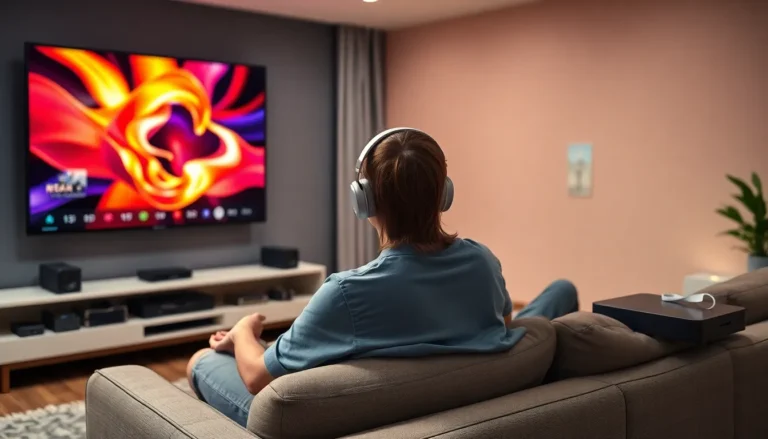In the world of music production, headphones aren’t just a luxury; they’re a necessity. Mixing tracks with the wrong pair can be like trying to bake a cake without sugar—sure, you might end up with something, but it won’t be sweet! The right headphones can make all the difference, helping to reveal every subtle nuance in your mix while keeping your neighbors blissfully unaware of your late-night jam sessions.
Table of Contents
ToggleOverview of Headphones for Mixing
Choosing the right headphones for mixing significantly impacts music production. Quality headphones enhance the ability to hear nuanced frequencies that are crucial during the mixing process. Closed-back and open-back headphones serve different purposes. Closed-back headphones provide isolation, making them suitable for environments where sound leakage could disrupt others. Open-back headphones, on the other hand, offer a more natural soundstage, making mixing more transparent.
Critical factors to consider include frequency response and comfort. A flat frequency response ensures accurate sound reproduction, preventing any coloration that may lead to poor mixing decisions. Comfort becomes vital during long mixing sessions. Headphones with cushioned ear pads and adjustable headbands help maintain focus without discomfort.
Popular choices among audio professionals include models from brands like Audio-Technica, Sennheiser, and Beyerdynamic. These brands offer headphones specifically designed for mixing, ensuring high-fidelity audio. The Audio-Technica ATH-M50x, for example, is known for its detailed sound and durability. The Sennheiser HD 650 is favored for its smooth frequency response and comfort over extended periods.
Portability can also influence decisions. Some headphones fold or come with a carrying case, appealing to those who mix on the go. Mixing headphones should balance between sound quality and practical use.
Understanding these aspects helps producers select headphones that meet their mixing needs efficiently. Prioritizing quality, comfort, and sound accuracy makes a significant difference in achieving the desired mix.
Key Features to Consider

Selecting headphones for mixing involves assessing several critical features. Quality sound, comfort, and durability are among the top priorities.
Sound Quality
Sound quality plays a vital role in mixing. Headphones must accurately reproduce a wide range of frequencies. A frequency response of 20 Hz to 20 kHz is ideal, as it covers the human hearing range. Clarity and detail in sound reproduction allow producers to discern subtle nuances in tracks. Headphones with a flatter response are preferred for mixing, as they provide a more accurate representation of audio. This accuracy aids in achieving a well-balanced mix. Models like the Audio-Technica ATH-M50x excel in delivering pristine sound quality, reinforcing their popularity among professionals.
Comfort and Fit
Comfort affects productivity during long mixing sessions. Over-ear designs often provide a snug fit, helping to block out external noise. Adjustable headbands enhance comfort by ensuring a secure fit for different head sizes. Earpads made from soft materials contribute to prolonged use without discomfort. A lightweight design also reduces fatigue during extended periods of use. Opting for headphones that prioritize comfort allows producers to focus on their work without distraction. The Sennheiser HD 650 is a well-regarded option, noted for its comfort and sound quality.
Durability
Durability is essential for headphones meant for frequent use. Look for models built with robust materials that can withstand wear and tear. Replaceable parts, such as earpads and cables, add longevity, making maintenance easier. A sturdy design not only preserves performance but also eases transport for mobile mixing. Investing in durable headphones ensures they can handle the rigors of professional use. The Beyerdynamic DT 770 Pro is an example of a durable model favored in professional studios.
Types of Headphones for Mixing
Choosing the right type of headphones for mixing significantly impacts sound quality and user experience. Two main categories exist: open-back and closed-back headphones.
Open-Back Headphones
Open-back headphones enable a natural soundstage by allowing air and sound to pass through the ear cups. This design creates a sense of space, making them ideal for mixing and mastering tracks. Users often appreciate how these headphones provide a more accurate representation of music, as they mimics listening to speakers in a room. A common frequency response in open-back models aligns closely with natural hearing, often ranging from 20 Hz to 20 kHz. Popular examples include the Sennheiser HD 650 and the Beyerdynamic DT 1990 Pro. These models are well-regarded for their comfort during extended sessions, offering plush ear pads and adjustable headbands.
Closed-Back Headphones
Closed-back headphones excel in isolation, preventing sound leakage and external noise from interfering. This feature makes them suitable for recording and mixing in less-than-ideal environments. They provide a tighter bass response, making it easier to hear low-end frequencies clearly. Many professionals favor closed-back headphones for tracking vocals or instruments, where accuracy is crucial. Models like the Audio-Technica ATH-M50x and Beyerdynamic DT 770 Pro deliver precise sound reproduction and comfort. With rugged designs and padded ear cups, these headphones are built for long mixing sessions and frequent travel, ensuring they withstand the rigors of use.
Recommended Headphones for Mixing
Choosing the right headphones significantly impacts the mixing process. Below are recommended models across different price ranges to suit various needs.
Budget Options
For those on a budget, the Audio-Technica ATH-M40x stands out. It offers excellent sound isolation and a balanced sound signature, making it versatile for mixing. The Samson SR850 provides an open-back design, delivering a wider soundstage at an affordable price. Another notable option is the Sony MDR-7506, known for its detailed sound representation and comfort, perfect for long sessions.
Mid-Range Suggestions
In the mid-range category, the Beyerdynamic DT 770 Pro excels in closed-back design, ensuring superior sound isolation and comfort. Likewise, the Sennheiser HD 598 boasts an open-back design with a pleasant frequency response, ideal for mixing and casual listening. The Focal Listen Professional also impresses, offering a clear and detailed sound profile, making it suitable for professional mixing environments.
High-End Choices
High-end selections include the renowned Sennheiser HD 650, celebrated for its natural sound reproduction and excellent comfort. The Beyerdynamic DT 1990 Pro features superior build quality and exceptional detail, ideal for critical listening. Additionally, the Focal Utopia is a premium option with outstanding clarity and a precise sound signature, perfect for mixing in high-fidelity environments. Each of these choices caters to serious audio professionals seeking top-tier performance.
Tips for Using Headphones in Mixing
Choosing the right environment enhances mixing accuracy. A quiet space minimizes distractions, allowing for a focused auditory experience. Maintaining a consistent sound level prevents headphone fatigue during long sessions.
Regularly adjusting the audio balance optimizes clarity. This practice helps in identifying frequency issues that could distort the mix. Utilizing reference tracks offers a benchmark for evaluating sound quality and balance.
Positioning headphones correctly affects sound perception. Centering ear cups over the ears ensures a proper seal for closed-back models, improving isolation. For open-back headphones, ensuring a comfortable fit can enhance the natural soundstage.
Listening in short bouts supports prolonged focus. Taking breaks prevents ear fatigue, which can impact mixing decisions. It’s important to continually revisit designs while allowing fresh ears to assess the mix.
Utilizing equalization with headphones allows for a more tailored listening experience. Adjusting settings based on headphone frequency response can enhance detail retrieval. Incorporating a stereo imager can improve spatial awareness in mixing.
Carefully switching between headphones and monitors can provide balanced perspectives. Monitors help assess the mix in a room context while headphones allow for more intimate details. Continuous cross-referencing strengthens the final product.
Keeping an ear on practical usage ensures efficient workflow. Comfort and portability facilitate spontaneous mixing opportunities. Overall, a thoughtful approach to headphone use contributes to effective mixing strategies.
Selecting the right headphones for mixing is a crucial step in achieving professional-sounding tracks. Quality headphones not only reveal subtle details but also enhance the overall mixing experience. Whether opting for closed-back models for isolation or open-back designs for a natural soundstage, the choice significantly impacts the mixing process.
Investing in well-reviewed models from reputable brands ensures that producers can accurately hear and manipulate frequencies. By understanding the differences and considering comfort and practicality, anyone can elevate their mixing sessions. With the right headphones in hand, achieving a polished final product becomes much more attainable.






